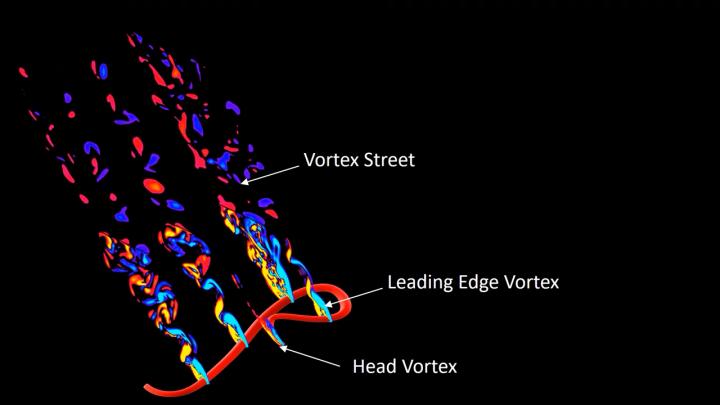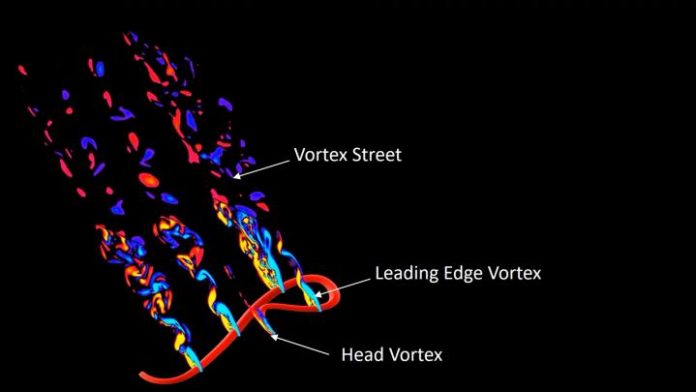
Photo: Preliminary 3D computational fluid dynamics calculations for a mesh based on actual flying snake experimental kinematic data from The Cube.
view more
Credit Image: Virginia Tech
Autonomous flight comes in many forms, in both nature and systems engineered by humans. While insects, birds and bats first come to mind as examples of creatures producing forces of flight, the paradise tree snake might be one of the least expected species we consider to examine and understand in terms of their complex aerial maneuvers.
With a cylindrical body, a snake has no extendable surfaces such as wings or flaps to create or and control their flight. Yet the Asian arboreal snakes of the genus Chrysopelea possess a surprisingly sophisticated ability to glide through the air. These snakes climb and jump from trees, flatten their body, and undulate in a complex three-dimensional pattern to produce aerial locomotion.
Over the past decade, Virginia Tech researchers Jake Socha and Shane Ross have collaborated on a number of studies focused on the Chrysopelea paradisi species, measuring and modeling the biomechanics of snake flight and the role aerial undulation plays. Ross is now taking the lead on a new study, aimed at determining the fundamental fluid dynamics of undulating aerial locomotion.
Ross, Socha and their multi-institutional collaborators, including Purdue University, have been awarded a new $639,919 grant from the National Science Foundation to study flying snakes and the fluid mechanics of deforming articulated bodies, extensible to movement of flexible bodies in other contexts.
The team at Virginia Tech’s previous work captured high-resolution movements of flying snakes through more than 100 live snake glides, from which a sophisticated 3D model was created. Through this research, which was funded by Socha’s NSF CAREER award from the Physics of Living Systems program, it was determined that the snakes use undulation, or sending waves down their body, to maintain stability.
“With this new study, we are going to really dive into detail on the fluid dynamics of the snake motion,” said Ross, a professor in the Kevin T. Crofton Department of Aerospace and Ocean Engineering. “We are hoping to get a full picture of how the snake uses its entire body as a morphing wing, continuously reconfiguring throughout flight, which makes it fundamentally different from any other biological or engineered flyer.”
Ross and Socha, a professor in the Department of Biomedical Engineering and Mechanics, and their collaborators will take a closer look at the surprising way in which the snakes actively maneuver in the air, to determine the fundamental fluid mechanics, combined with dynamics and control, that underlie the essential dynamics of snake flight.
In a developed glide, flying snakes move downward at a shallow angle and are able to cover significant horizontal distance. The snake is stable and under control in the air, and able to recover from instabilities. Even more surprisingly, the snake can actively maneuver in the air, with turns of 90 degrees that can occur in the space of a meter.
Unlike other animal flyers, the snake sends high-amplitude traveling waves down the body, effectively making the snake into a tandem or triple wing, where the front and rear segments can be aerodynamically coupled. In a stark contrast to almost all other flyers in nature, the snake’s body posture is asymmetrical about any axis at any moment in time. It is unknown how the snake produces a stable forward gliding motion, and yet is also highly agile, capable of active maneuvering.
The research team will be testing the hypothesis that this coupling is achieved through feedback between self-deformations, or undulation, and unsteady fluid mechanics. A combination of interdisciplinary approaches will be used, including animal experiments, fluid laboratory experiments, computational methods, and dynamics and control theory.
A new round of experiments with live snakes, this time focused on dynamics and control, will be conducted at Virginia Tech: first in the The Cube, a black-box theater at the Moss Arts Center, and later outdoors with a custom camera rig focusing on the shallowing phase of gliding.
Ross and Socha have partnered with researchers at Purdue University and other university teams to execute the laboratory fluid experiments and computational fluid dynamics studies. Pavlos Vlachos of Purdue (and formerly of Virginia Tech) will investigate the lift and drag distribution along the body under different flow conditions. Using 3D-printed rigid models representative of the snakes’ changing body posture during glides, these fluid experiments will be executed in a towing tank facility and underwater Tomo-PIV system at Purdue.
The multi-university team will also investigate unsteady fluid dynamics and dynamic response through computational fluid dynamics studies. A fully coupled model of a morphing airfoil will consider the effect of the force distribution on the snake body’s self-deforming kinematics, and will address whether the vertical waves are the cause or the effect of lift production. With better understanding of the physics, the interdependencies of the kinematics, dynamics, and fluid dynamics of dynamic systems will be revealed.
Through this research, the team hopes to advance the science, engineering, and design of robotics in complex environments, and help change the culture of how coupled translational-rotational dynamics are handled in fluid environments. The proposed experimental and computational framework can potentially redefine the form and function of locomotion in fluid media for aerial and underwater robotic systems with enhanced mobility.
“There is already a pretty well developed field of snake robotics,” Ross concluded. “By adding in a new modality or locomotion ability, we can advance their abilities in climbing through rubble, up poles, or along the side of a building. With a better understanding of the fluid dynamics, we can start to build robotic snakes prototypes for applications in surveillance, search and rescue, or to be used in complex urban environments.”
###
Written By Jama Green
TDnews (tunisiesoir.com)















